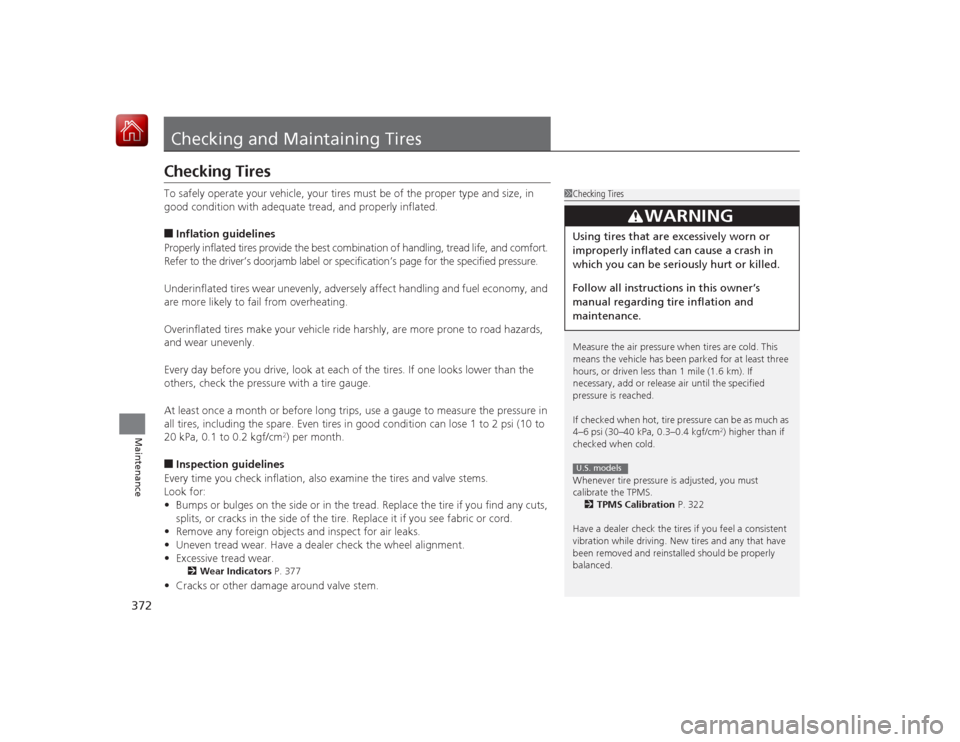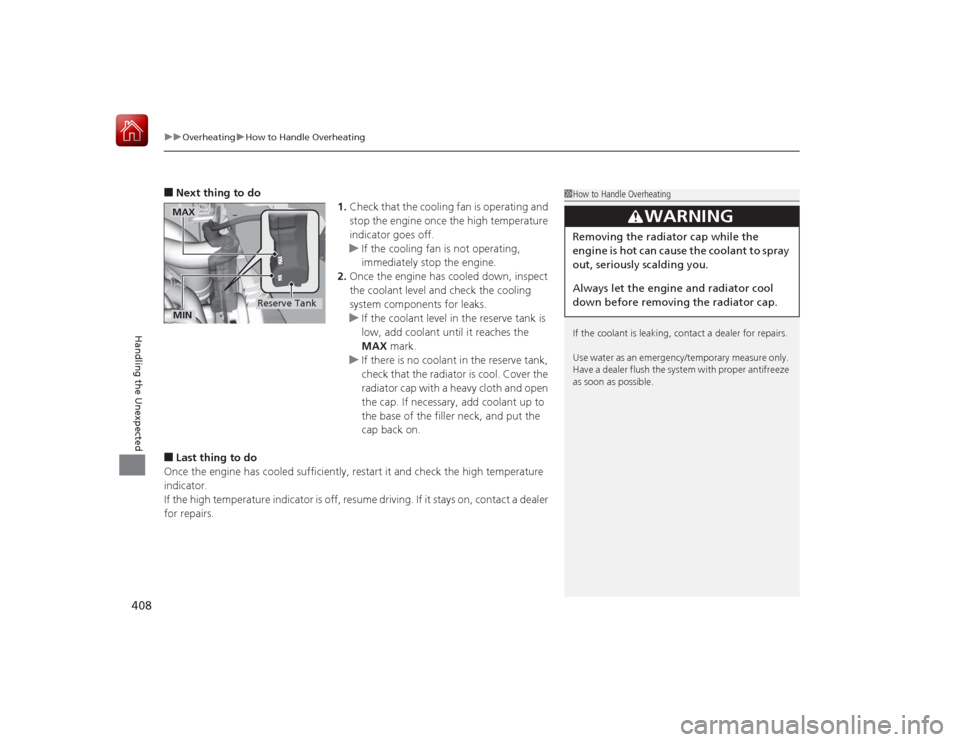2015 HONDA CIVIC COUPE overheating
[x] Cancel search: overheatingPage 3 of 441

Contents
This owner’s manual should be considered a permanent part of the
vehicle and should remain with the vehicle when it is sold.
This owner’s manual covers all models of your vehicle. You may find
descriptions of equipment and features that are not on your
particular model.
Images throughout this owner’s manual (including the front cover)
represent features and equipment that are available on some, but
not all, models. Your particular mo del may not have some of these
features.
This owner’s manual is for vehicles sold in the United States and
Canada.
The information and specifications in cluded in this publication were
in effect at the time of approval for printing. Honda Motor Co., Ltd.
reserves the right, however, to discontinue or change specifications
or design at any time without notice and without incurring any
obligation.2 Safe Driving P. 25
For Safe Driving P. 26 Seat Belts P. 30 Airbags P. 37
2Instrument Panel P. 65
Indicators P. 66 Gauges and Multi-Information Display P. 81
2Controls P. 99
Clock P. 100 Locking and Unlocking the Doors P. 102
Opening and Closing the Moonroof* P. 121
Adjusting the Seats P. 137
2 Features P. 159
Audio System P. 160 Audio System Basic Operation P. 166, 184
Customized Features* P. 220 Bluetooth® HandsFreeLink ® P. 233, 264
2 Driving P. 291
Before Driving P. 292 Towing a Trailer P. 297
Refueling P. 332 Fuel Economy P. 335
2Maintenance P. 337
Before Performing Maintenance P. 338 Maintenance MinderTM P. 341
Checking and Maintaining Wiper Blades P. 370
Heating and Cooling System
*/Climate Control System* Maintenance P. 384
2 Handling the Unexpected P. 391
Tools P. 392 If a Tire Goes Flat P. 393
Overheating P. 407 Indicator, Coming On/Blinking P. 409
2Information P. 419
Specifications P. 420 Identification Numbers P. 424
Emissions Testing P. 427 Warranty Coverages P. 429
Page 22 of 441

Quick Reference Guide21
Handling the Unexpected
(P391)
Flat Tire
(P393)
● Park in a safe location and replace the
flat tire with the compact spare tire in the
trunk.
Indicators Come On (P409)
●Identify the indicator and consult the
owner's manual.
Engine Won't Start (P 400)
●If the battery is dead, jump start using a
booster battery.Blown Fuse
(P413)
● Check for a blown fuse if an electrical
device does not operate.
Overheating
(P407)
● Park in a safe location. If you do not see
steam under the hood, open the hood,
and let the engine cool down.
Emergency Towing (P417)
●Call a professional towing service if you
need to tow your vehicle.
* Not available on all models
Page 71 of 441

70
uuIndicators u
Instrument Panel
*1:Models with the smart entry system have an ENGINE START/STOP button instead of an ignition switch.Indicator
Name
On/Blinking
Explanation
Message
Supplemental
Restraint System
Indicator
●Comes on for a few seconds when
you turn the ignition switch to ON (w
*1, then goes off.
●Comes on if a problem with any of
the following is detected:
-Supplemental restraint system
- Side airbag system
- Side curtain airbag system
- Seat belt tensioner
●Stays on constantly or does not
come on at all - Have your vehicle
checked by a dealer.
High Temperature
Indicator
●Comes on for a few seconds when
you turn the ignition switch to ON (w
*1, then goes off.
●Blinks when the engine coolant
temperature goes up, and stays on if
the temperature continues to rise.
●Blinks while driving - Drive slowly to
prevent overheating.●Stays on while driving - Immediately
stop in a safe place and allow the
engine to cool.
2 Overheating P. 407
Low Temperature
Indicator
●Comes on for a few seconds when
you turn the ignition switch to ON (w
*1, then goes off.
●Comes on when the engine coolant
temperature is low.
●If the indicator stays on after the
engine has reached normal operating
temperature, there may be problem
with the temperature sensors. Have
your vehicle inspected by a dealer.
—
Page 373 of 441

372Maintenance
Checking and Maintaining TiresChecking TiresTo safely operate your vehicle, your tires must be of the proper type and size, in
good condition with adequate tread, and properly inflated.■Inflation guidelines
Properly inflated tires provide the best combination of handling, tread life, and comfort.
Refer to the driver’s doorjamb label or sp ecification’s page for the specified pressure.
Underinflated tires wear unevenly, adversely affect handling and fuel economy, and
are more likely to fail from overheating.
Overinflated tires make your vehicle ride harshly, are more prone to road hazards,
and wear unevenly.
Every day before you drive, look at each of the tires. If one looks lower than the
others, check the pressure with a tire gauge.
At least once a month or before long trips, use a gauge to measure the pressure in
all tires, including the spare. Even tires in good condition can lose 1 to 2 psi (10 to
20 kPa, 0.1 to 0.2 kgf/cm
2) per month.
■Inspection guidelines
Every time you check inflation, also examine the tires and valve stems.
Look for:
• Bumps or bulges on the side or in the tread. Replace the tire if you find any cuts,
splits, or cracks in the side of the tire. Re place it if you see fabric or cord.
• Remove any foreign objects and inspect for air leaks.
• Uneven tread wear. Have a dealer check the wheel alignment.
• Excessive tread wear.2 Wear Indicators P. 377
•Cracks or other damage around valve stem.
1Checking Tires
Measure the air pressure when tires are cold. This
means the vehicle has been par ked for at least three
hours, or driven less than 1 mile (1.6 km). If
necessary, add or release air until the specified
pressure is reached.
If checked when hot, tire pressure can be as much as
4–6 psi (30–40 kPa, 0.3–0.4 kgf/cm
2) higher than if
checked when cold.
Whenever tire pressure is adjusted, you must
calibrate the TPMS. 2 TPMS Calibration P. 322
Have a dealer check the tires if you feel a consistent
vibration while driving. New tires and any that have
been removed and reinstalled should be properly
balanced.
3
WARNING
Using tires that are excessively worn or
improperly inflated can cause a crash in
which you can be seri ously hurt or killed.
Follow all instruc tions in this owner’s
manual regarding tire inflation and
maintenance.U.S. models
Page 392 of 441

391
Handling the Unexpected
This chapter explains how to handle unexpected troubles.
Tools
Types of Tools .................................. 392
If a Tire Goes Flat Changing a Flat Tire ......................... 393
Engine Does Not Start Checking the Engine ........................ 400If the Smart Entry Remote Battery is Weak ... 401Emergency Engine Stop ................... 402
Jump Starting .................................... 403
Shift Lever Does Not Move .............. 406
Overheating How to Handle Overheating ............. 407 Indicator, Coming On/Blinking
If the Low Oil Pressure Indicator Comes On .. 409If the Charging System Indicator Comes
On ................................................. 409
If the Malfunction Indicator Lamp Comes On or Blinks ................................... 410
If the Brake System Indicator (Red) Comes On ................................................. 411
If the Electric Power Steering (EPS) System
Indicator Comes On ....................... 411
If the Low Tire Pressure/TPMS Indicator Comes On or Blinks........................ 412 Fuses
Fuse Locations ................................. 413
Inspecting and Changing Fuses ........ 416
Emergency Towing ........................... 417
Page 408 of 441

407
Continued
Handling the Unexpected
OverheatingHow to Handle OverheatingOverheating symptoms are as follows:
•The high temperature indicator comes on or the engine suddenly loses power.
• Steam or spray comes out of the engine compartment.■First thing to do
1. Immediately park the vehicle in a safe place.
2. Turn off all accessories and turn on the hazard warning lights.
u No steam or spray present: Keep the engine running and open the hood.
u Steam or spray is present: Turn off the engine and wait until it subsides.
Then open the hood.
1 How to Handle OverheatingNOTICEContinuing to drive with the high temperature
indicator on may damage the engine.
3
WARNING
Steam and spray from an overheated
engine can seriously scald you.
Do not open the ho od if steam is coming
out.
Page 409 of 441

uuOverheating uHow to Handle Overheating
408Handling the Unexpected
■Next thing to do
1.Check that the cooling fan is operating and
stop the engine once the high temperature
indicator goes off.
u If the cooling fan is not operating,
immediately stop the engine.
2. Once the engine has cooled down, inspect
the coolant level and check the cooling
system components for leaks.
u If the coolant level in the reserve tank is
low, add coolant until it reaches the
MAX mark.
u If there is no coolant in the reserve tank,
check that the radiator is cool. Cover the
radiator cap with a heavy cloth and open
the cap. If necessary, add coolant up to
the base of the filler neck, and put the
cap back on.■Last thing to do
Once the engine has co oled sufficiently, restart it and check the high temperature
indicator.
If the high temperature indicator is off, resume driving. If it stays on, contact a dealer
for repairs.
1 How to Handle Overheating
If the coolant is leaking, contact a dealer for repairs.
Use water as an emerge ncy/temporary measure only.
Have a dealer flush the system with proper antifreeze
as soon as possible.
3
WARNING
Removing the radiator cap while the
engine is hot can cause the coolant to spray
out, seriously scalding you.
Always let the engine and radiator cool
down before removing the radiator cap.
MAX
Reserve Tank
MIN
Page 435 of 441

434Index
Brake System............................................. 326
Anti-lock Brake System (ABS) ................... 328
Brake Assist System ................................. 329
Fluid ........................................................ 358
Foot Brake ............................................... 327
Indicator .................................................... 66
Indicator (Amber)....................................... 66
Indicator (Red) ......................................... 411
Parking Brake .......................................... 326
Brake System Indicator (Amber) ................ 66
Brightness Control (Instrument Panel) .... 132
Bulb Replacement ..................................... 360
Brake Lights, Taillights, Re ar Side Marker lights,
Back-Up Lights and Rear Turn Signal
Lights..................................................... 367
Fog Lights ................................................ 364
Front Turn Signal/Parking/Side Marker
Lights..................................................... 365
Headlights ............................................... 360
High-Mount Brake Light .......................... 369
Rear License Plate Light............................ 368
Bulb Specifications ............................ 420, 422CCarbon Monoxide Gas ................................ 62
Carrying Cargo .................................. 293, 295
CD Player ........................................... 171, 194
Center Pocket ............................................ 148
Certification Label .................................... 424
Changing Bulbs ......................................... 360 Charging System Indicator
................. 67, 409
Child Safety ................................................. 50
Emergency Trunk Opener ........................ 115
Child Seat .................................................... 50
Booster Seats ............................................ 61
Child Seat for Infants................................. 52
Child Seat for Small Children ..................... 53
Installing a Child Seat with a Lap/Shoulder Seat
Belt ......................................................... 57
Larger Children ......................................... 60
Rear-facing Child Seat ............................... 52
Selecting a Child Seat ................................ 54
Using a Tether ........................................... 59
Cleaning the Exterior ............................... 387
Cleaning the Interior ................................ 385
Climate Control System ............................ 155
Changing the Mode ................................ 155
Defrosting the Windshield and Windows ............................................... 156
Dust and Pollen Filter............................... 384
Recirculation/Fresh Air Mode ................... 156
Sensors ................................................... 157
Using Automatic Climate Control ............ 155
Clock .......................................................... 100
Clutch Fluid ............................................... 358
Coat Hook ................................................. 150
Compact Spare Tire .................. 393, 421, 423
Console Compartment ............................. 147
Continuously Variable Transmission Creeping ................................................. 304
Fluid ........................................................ 357 Kickdown ............................................... 304
Operating the Shift Lever .......... 18, 306, 308
Shift Lever Does Not Move ...................... 406
Shifting ........................................... 305, 307
Controls ...................................................... 99
Coolant (Engine) ...................................... 355
Adding to the Radiator ........................... 356
Adding to the Reserve Tank .................... 355
High Temperature Indicator ...................... 70
Low Temperature Indicator ....................... 70
Overheating ............................................ 407
Creeping (Continuously Variable Transmission) .......................................... 304
Cruise Control .......................................... 315
Indicator ................................................... 75
Cup Holders .............................................. 149
Customer Service Information ................ 432
Customized Features ......................... 87, 220
DDaytime Running Lights .......................... 130
Dead Battery ............................................ 403
Defrosting the Windshield and
Windows ......................................... 154, 156
Devices that Emit Radio Waves ............... 425
Dimming
Headlights .............................................. 127
Rearview Mirror ...................................... 135
Dipstick (Engine Oil) ................................ 349
Directional Signals (Turn Signal) ............. 127